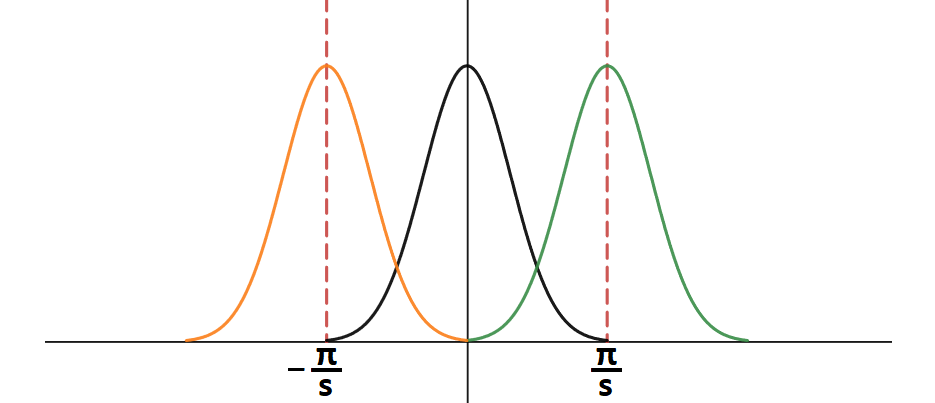TL;DR The idea is to modify the continuous-time representation of the filter, $f(t)$, such that it's suitable for discrete-time sampling - mainly by accounting for aliasing via "folding" in Fourier domain. The operation is also equivalent to (and used for) subsampling.
"Periodization" refers to the fact that sampling $f(t)$ at uniform intervals $s$ corresponds to making its Fourier transform $2\pi/s$-periodic.
Periodizing
A uniform sampling of $f$ with interval $s$ can be expressed as a weighted Dirac sum:
$$
f_d(t) = \sum_{n=-\infty}^{\infty} f(ns) \delta (t - ns) \tag{1}
$$
Fourier transform of $\delta(t - ns)$ is $e^{-jns\omega }$, so the Fourier transform of $f_d$ is
$$
\hat f_d (\omega) = \sum_{n=-\infty}^{\infty} f(ns) e^{-ins\omega} \tag{2}
$$
($f(ns)$ is the "weights" and thus constant in transform over $t$). It can be shown${}^1$ that this is same as
$$
\hat f_d (\omega) = \frac{1}{s}\sum_{k=-\infty}^{\infty} \hat f \left( \omega - \frac{2\pi}{s}k \right) \tag{3}
$$
That is, sampling $f$ at intervals $s$ is equivalent to making its Fourier transform $2\pi/s$-periodic by summing all its translations $\hat f (\omega - (2\pi / s)k)$. This makes more sense with what follows.
Sampling
(Shannon-Whittaker sampling theorem) If the support of $\hat f$ is bounded in $[-\pi/s, \pi/s]$, then
$$
f(t) = \sum_{n=-\infty}^{\infty} f(ns) \phi_s(t - ns), \tag {4}
$$
where
$$
\phi_s(t) = \frac{\sin{( (\pi/s)t )}}{(\pi / s) t}. \tag{5}
$$
Note, if $n \neq 0$, the support of $\hat f(\omega - (\pi / s)n)$ does not intersect the support of $\hat f (\omega)$ because $\hat f(\omega) = 0 $ for $|\omega| > \pi / s$. So $(3)$ implies
$$
\hat f_d (\omega) = \frac{\hat f(\omega)}{s}\ \ \text{if}\ \ |\omega| \leq \frac{\pi}{s} \tag{6}
$$
Fourier transform of $\phi_s$ is $\hat \phi_s = s \bf{1}_{[-\pi/s, \pi/s]}$ (indicator function, or "box"). Since the support of $\hat f$ is in $[-\pi/s, \pi/s]$, it follows from $(6)$ that $\hat f(\omega) = \hat \phi_s(\omega) \hat f_d(\omega)$. Its inverse Fourier transform gives
$$
\begin{align}
f(t) = \phi_s \star f_d(t)
&= \phi \star \sum_{n=-\infty}^{\infty} f(ns) \delta(t - ns) \\
&= \sum_{n=-\infty}^{\infty} f(ns) \phi_s(t - ns) \tag{7}
\end{align}
$$
This happens to be a proof of the theorem.
Sampling $\Leftrightarrow$ Periodizing
This can be seen as follows; suppose $\hat f$'s support is in $[-\pi/s, \pi/s]$. Then:

$(a)$ is simply $f(t)$ and its F.T. Sampling it at uniform interval $s$ has the effect of adding translations of its F.T. (i.e. $(3)$), which is what's shown - original $\hat f(\omega)$ translated and centered at multiples of $(2\pi /s)$. These "duplicates" extend out to infinity; we've thus "periodized" the Fourier transform of $f(t)$.
Per $(7)$, we recover $f(t)$ from $f_d(t)$ by convolving with $\phi_s$ (or multiplying in Freq domain):

Subsampling
Let's pose it as a problem: what effect does subsampling (i.e. taking every $k$-th sample) of a finite sequence $x[n] = [4, 7, ..., -1]$ have on its Fourier transform? Note this is equivalent to scaling the sampling interval: $s \rightarrow ks$. Suppose we wish to subsample by 2.
To answer this, we first visit aliasing.
Aliasing
In case $\hat f$ isn't bound to $[-\pi/s, \pi/s]$, the resulting $f_d(t)$ will alias. From $(3)$ and proof of $(4)$, we can predict this manifests as overlaps in Fourier domain:

The translations are still spaced by $(2\pi / s)$, while support of $\hat f$ exceeds it, yielding overlaps. The sampled $f_d(t)$ will then no longer resemble $f(t)$:

Subsampling (cont'd)
If $k=2$, we double our $s$, and thus halve the support $[-\pi/s, \pi/s]$. To subsample without aliasing, $\hat f$'s support must thus lie in $[-\pi/(2s), \pi/(2s)]$ (per original $s$):

Now suppose it isn't, and the support lies exactly in $[-\pi/s, \pi/s]$. Then:

What is the resulting $\hat f_d$? Well, it's simply the negative half of $\hat f(\omega)$ added to its positive half, and vice versa ("folding") - then divided by 2 (s *= 2 in eq $(3)$).
This is exactly what
$$
v_f[k] = \frac{1}{k} \sum_{i=0}^{\text{n_periods}-1} h_f[i\cdot N + k], \tag{8}
$$
(expression in question) is doing, but instead with DFT bins, where the de-facto support w.r.t. continuous-time input is $[-\pi/s, \pi/s]$ (with or without aliasing).
Put one way, subsampling simulates the effects of aliasing. In code, the following holds (assume fold() implements $(8)$):
ifft(fold(fft(x), k)) == x[::k]
Periodizing a filter
Does $(8)$ serve any purpose beyond subsampling? Correctness: if we disregard folding and pretend aliasing isn't there, result's even worse than with aliasing.
More generally, given some arbitrary continuous-time function of a filter in Fourier domain, $\hat \psi(\omega)$, how do we sample it such that the entire support (assuming finite) is included, and that we use exactly $N$ samples? One approach is, "sample lots, then subsample" - which is exactly what Kymatio's morlet_1d does. (The alternative is to determine correct sampling bounds and get it right the first time.)
Once we have the correct $\hat \psi_d(\omega)$ that accounts for aliasing and captures at least one full period of the continuous-time function (i.e. $[-\pi/s, \pi/s]$), then $\hat \psi_d(\omega)$ is the correct continuous-time function, whether without or with aliasing, and taking IFFT we get closest to what we'd get with sampling the continuous-time $\psi (t)$ with rate $f_s=1/s$ (over one continuous-time period).
References
Figures and formulae (with much accompanying wording copied verbatim) taken from S. Mallat's Wavelet Tour, sections 3.1.0-3.1.2, where further explanations and proofs are given (including to footnote 1).






